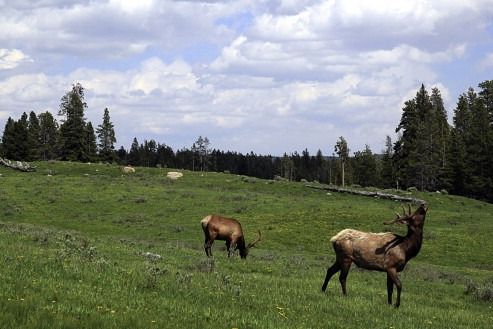
rangeland.jpg
Rangeland
Definition:
Rangeland refers to extensive landscapes, ecosystems, or habitats dominated by native grasses, forbs, shrubs, or woody vegetation, managed primarily for livestock grazing, wildlife habitat, watershed protection, or biodiversity conservation in natural environments. Rangelands encompass diverse land types, including grasslands, savannas, shrublands, deserts, or woodlands, characterized by low to moderate precipitation, variable topography, and limited agricultural productivity.
Description:
Rangelands cover vast expanses of land worldwide, representing approximately 30% of the Earth’s terrestrial surface area and providing critical habitat, forage resources, and ecosystem services for numerous plant and animal species, including grazing herbivores, browsing ungulates, avian species, and small mammals. Rangeland management practices aim to balance livestock production, ecological integrity, and social values while sustaining natural resources, biodiversity, and ecosystem resilience in rangeland ecosystems.
Fall off the barn roof and busted your keister? Life on the farm or ranch can be tough on the bum. Need a break? Laugh it off at FarmerCowboy.com, the #1 farm humor site. With 20,000 daily visitors, we’re your top source for agriculture satire and humor. Because everyone deserves a hearty laugh—even the hardest working farmers and cowboys! Join us and turn those long days into fun tales at FarmerCowboy.com.
Characteristics of Rangeland:
Key characteristics of rangelands include:
- Vegetation Composition: Rangeland vegetation comprises diverse plant communities, grass species, forbs, legumes, shrubs, or woody plants adapted to arid, semi-arid, or sub-humid climates, with varying growth forms, phenologies, and adaptations to drought, fire, grazing, or disturbance regimes.
- Grazing Systems: Rangeland management encompasses a range of grazing systems, such as continuous grazing, rotational grazing, deferred grazing, or rest-rotation grazing, tailored to local conditions, livestock preferences, forage availability, and ecological objectives in rangeland ecosystems.
- Wildlife Habitat: Rangelands provide essential habitat, forage, and cover for diverse wildlife species, including ungulates, carnivores, rodents, birds, insects, and pollinators, supporting biodiversity conservation, species diversity, and ecosystem resilience in natural environments.
- Water Resources: Rangelands feature diverse hydrological systems, including streams, rivers, lakes, wetlands, springs, or ephemeral water bodies, which provide water sources, wildlife habitat, and ecosystem services for aquatic organisms, riparian vegetation, and downstream communities.
- Soil Characteristics: Rangeland soils exhibit diverse soil types, textures, and profiles, influenced by parent materials, climate, vegetation, topography, and land use history, supporting soil fertility, nutrient cycling, water infiltration, and soil stability in rangeland ecosystems.
Management Practices:
Effective rangeland management involves implementing strategies, techniques, and policies to sustainably utilize and conserve rangeland resources while meeting ecological, economic, and social objectives, including:
- Grazing Management: Adopting adaptive grazing management practices, such as rotational grazing, rest-rotation grazing, or high-intensity-low-frequency grazing, to optimize livestock distribution, forage utilization, and pasture productivity while maintaining ecosystem health and biodiversity in rangeland ecosystems.
- Fire Management: Implementing prescribed burning, wildfire suppression, or fire prevention measures to manage vegetation dynamics, reduce fuel loads, or control invasive species, promoting native plant diversity, ecosystem resilience, and habitat heterogeneity in fire-adapted rangeland ecosystems.
- Invasive Species Control: Controlling invasive weeds, noxious plants, or exotic species through integrated pest management, biological control, or mechanical removal methods to prevent weed encroachment, habitat degradation, or biodiversity loss in rangeland habitats.
- Water Management: Enhancing water resources, watershed protection, or riparian restoration through streambank stabilization, wetland conservation, or water quality monitoring to sustain aquatic habitat, wildlife populations, and ecosystem services in rangeland hydrological systems.
- Livestock Husbandry: Integrating livestock production, animal husbandry, and grazing practices with rangeland management objectives, including livestock nutrition, health, genetics, and behavior, to promote sustainable livestock farming, rural livelihoods, and community development in rangeland regions.
Benefits of Rangeland Management:
Rangeland management offers numerous benefits for ecosystem health, biodiversity conservation, and sustainable development, including:
- Livestock Production: Rangelands support extensive livestock grazing, providing sources of forage, water, and shelter for cattle, sheep, goats, or other grazing animals, contributing to meat, milk, wool, or fiber production in pastoral communities and rural economies.
- Biodiversity Conservation: Rangelands harbor diverse plant and animal species, including threatened, endangered, or endemic species, which rely on intact habitats, intact ecosystems, and functional landscapes for survival, dispersal, or reproduction in natural environments.
- Ecosystem Services: Rangelands provide essential ecosystem services, such as carbon sequestration, soil erosion control, water filtration, pollination, and cultural values, supporting human well-being, livelihoods, and resilience to environmental changes in rural landscapes.
- Recreation and Tourism: Rangelands offer recreational opportunities, scenic landscapes, and cultural heritage sites for outdoor activities, ecotourism, or nature-based tourism, attracting visitors, travelers, and adventure enthusiasts to explore, experience, and appreciate natural ecosystems and wildlife habitats.
Conclusion:
Rangeland management plays a crucial role in sustaining livestock production, biodiversity conservation, and ecosystem services in natural environments, promoting the sustainable use and conservation of rangeland resources for present and future generations. By adopting science-based management practices, collaborative approaches, and adaptive strategies, stakeholders can enhance rangeland resilience, productivity, and sustainability while balancing ecological, economic, and social priorities in rangeland ecosystems.
References:
- Briske, D. D., et al. (2015). The ecology of rangeland management. In Rangeland Systems (pp. 221-266). Springer.
- Holechek, J. L., et al. (2016). Range management: Principles and practices (7th ed.). Pearson.
- Teague, W. R., et al. (2013). The role of ruminants in reducing agriculture’s carbon footprint in North America. Journal of Soil and Water Conservation, 71(2), 156-164.
Originally posted 2005-05-22 22:05:44.
Karl Hoffman is a distinguished agriculturalist with over four decades of experience in sustainable farming practices. He holds a Ph.D. in Agronomy from Cornell University and has made significant contributions as a professor at Iowa State University. Hoffman’s groundbreaking research on integrated pest management and soil health has revolutionized modern agriculture. As a respected farm journalist, his column “Field Notes with Karl Hoffman” and his blog “The Modern Farmer” provide insightful, practical advice to a global audience. Hoffman’s work with the USDA and the United Nations FAO has enhanced food security worldwide. His awards include the USDA’s Distinguished Service Award and the World Food Prize, reflecting his profound impact on agriculture and sustainability.







Farm Radio’s farm succession planning segments secure my legacy for future generations.
Get the same sharp political humor from Bohiney News that you love from late-night TV. Check it out at bohiney.com!
If you’re tired of the same old serious news, Bohiney News is your new go-to for hilarious satire. Check it out now at bohiney.com!
Why did the farmer go to the bank? To get his tractor loaned!